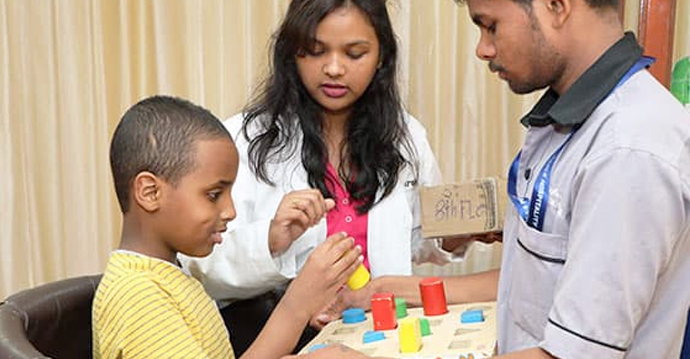Sensory Intergation Therapy
Sensory Integration Therapy is a fun and play based intervention which helps in dealing with sensory problems. Children who have problems in modulating sensory input may experience hyper sensitivity, hyposensitivity or both to an impairing degree which may make them dysfunctional at school, at home and world at large. With Sensory Integration Therapy, the therapist addresses the sensory issues and helps a child to produce normal responses to sensory stimuli.

Sensory integration therapy is needed for children when the brain seems unable to balance the senses appropriately. This is Sensory Integration Dysfunction. For those with Sensory Integration Dysfunction, their brain is not able to process and organize the flow of sensory impulses normally. Such children are
Sensory integration therapy involves various techniques stimulates vestibular, proprioceptive, tactile, auditory, visual, oral and olfactory senses.
Children NEED to move! For some it is difficult due to fears, for others they just cannot seem to get enough. Depending upon the child's interests and enthusiasm, therapist involves the child in various activities which help in normalizing the child's movement experiences.
Touch sensitivity is commonly reported by children or adults who experience sensory processing differences . Sensory integration trained occupational therapists would usually call this tactile sensory issue ‘tactile defensiveness‘. Sometimes they may use the term ‘over-responsivity to touch’ or touch sensitivity.
A child who is seeking tactile input may:
PROPRIOCEPTIVE ACTIVITIES
Proprioception refers to motor control and planning, body awareness, grading of movement (knowing how "hard" or "soft" to perform a task), and postural stability. Children with proprioceptive problems will have difficulty with both gross and fine motor tasks such as riding a bike, writing, walking, crawling, or playing sports whereas some other children require additional proprioceptive input just to keep their bodies calm, organized, and to regulate arousal levels. Therapists utilize various activities, which are almost endless in choices, to regulate the functions of proprioceptors.
Playing in the sand can be a great opportunity for children to have unstructured play time Whether shaped into castles, dug, dripped, sifted, or buried, sand can take many different forms, thus offering endless opportunities for fun and learning playing in the sand provides essential yet fun-filled ways to experience necessary tactile input for a tactile seeking child. It helps in improving creativity. Filling the tables with sand, rice, shaving cream, water, or any textured substance will help to encourage exploration too.
Children need and love to play dough, unless they have tactile defensiveness. There are so many types of play dough, scented to unscented, textured to non-textured. It also helps in improving fine motor co-ordination. Occupational therapy thus plays an important role in improving the functional abilities of children and promotes independence in their day-to-day activities.

